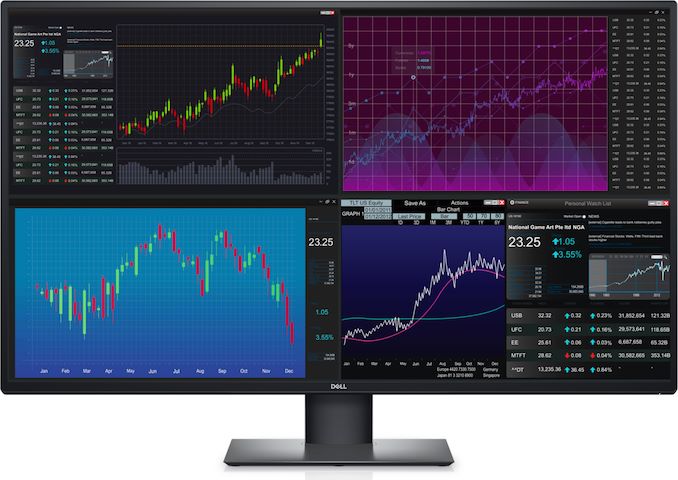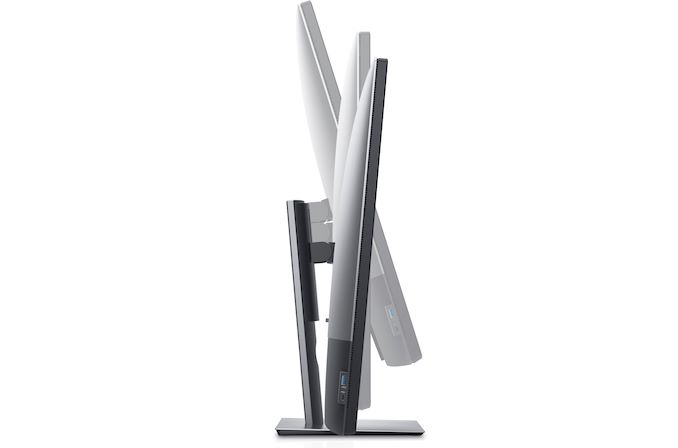CES 2020: Dell Announces UltraSharp U4320Q 42.5-Inch 4K IPS Monitor
by Anton Shilov on January 2, 2020 10:00 AM EST
Dell was among the first companies to introduce a 43-inch monitor designed for office and environments where multi-display configurations have traditionally been used. At CES, the company rolled out its new UltraSharp U4320Q 42.5-Inch 4K display that features a newer panel, an improved stand, and a USB-C input.
Dell continues to position its UltraSharp U4320Q monitor as an ultimate tool for productivity applications as well as a replacement for multiple smaller displays. To that end, specifications of the display are pretty modest: a 3840×2160 resolution, 350 nits typical brightness, a 1000:1 contrast ratio, 178°/178° horizontal/vertical viewing angles, a 5 ms GtG response time in Fast mode, and a 60 Hz refresh rate. The display does not support HDR10 transport, a variable refresh rate technology, and other multimedia enhancements. Being a ‘workhorse’ type monitor, the UltraSharp U4320Q supports only sRGB color gamut, which is good enough for Windows.
The key improvement that the UltraSharp U4320Q has over its predecessor is its adjustable stand that can now regulate height, tilt, and swivel, as well as a modernized set of connectors. In addition to usual DisplayPort and HDMI inputs, the new unit has a USB Type-C port that supports DisplayPort alt mode and can deliver up to 90 W of power to the host. The monitor fully supports Picture-by-Picture and Picture-in-Picture capabilities and can work with up to four PCs at once. Unfortunately, the display does not have a built-in KVM. Moreover, it does not have built-in speakers either.
| Dell's 43-Inch Monitors | ||||
| UltraSharp U4320Q | P4317Q | |||
| Panel | 42.5" IPS | |||
| Resolution | 3840 × 2160 | |||
| Refresh Rate | 60 Hz | |||
| Variable Refresh Rate | - | |||
| Response Time | 5 ms GtG in Fast mode 8 ms GtG in Normal mode |
8 ms GtG | ||
| Brightness | 350 cd/m² | 350 cd/m² | ||
| Contrast | 1000:1 Typical | |||
| Viewing Angles | 178°/178° horizontal/vertical | |||
| PPI | 104 pixels per inch 0.245 mm² pixel pitch |
|||
| Colors | 1.07 billion | |||
| Inputs | 2 × DisplayPort 1.4 2 × HDMI 2.0 1 × USB Type-C w/ DP Alt Mode |
1 × DisplayPort 1 × Mini DisplayPort 2 × HDMI 1 × D-Sub/VGA |
||
| USB-C PD | 90 W | - | ||
| USB Hub | 4-port USB 3.0 hub (3×USB-A and USB-C) | 4-port USB 3.0 Type-A hub | ||
| Audio | Headphone Output | 8W Stereo Speakers Headphone Output Audio Input |
||
| Stand | Height: -/+60 mm Tilt: -5° to 10° Swivel: -20° to 20° |
Tilt: -5° to 10° | ||
| Launch Date | January, 2020 | May, 2016 | ||
| Launch Price | $1,049.99 | $899.99 (?) | ||
Dell’s UltraSharp U4320Q will be available starting January 30, 2020, at an MSRP of $1049.99.
Related Reading:
- Dell U4919DW Curved Display Unveiled: 49 Inches, 5120x1440
- LG Unveils 43UN700 Monitor: 42.5-Inch 4K w/ HDR10 for Work & Gaming
- LG 43UD79-B Launched: 42.5-inch 4K IPS with FreeSync
- Philips Unveils 43-Inch 4K Gaming LCD with DisplayHDR 1000, DCI-P3, FreeSync
- IO Data Announces M4K651XDB: A 4K 64.5-Inch Display with HDR10
- JapanNext 75 and 86-Inch 4K IPS HDR Monitors: What Separates TVs from Monitors, Anyhow?
Source: Dell













29 Comments
View All Comments
ABR - Thursday, January 2, 2020 - link
"I n addition to usual DisplayPort and HDMI inputs, the new unit has a USB Type-C port." The proliferation of ways to connect a computer to a display borders on ridiculous.lilkwarrior - Thursday, January 2, 2020 - link
In 2020, Having DP 2.0 (late fall), Thunderbolt 3 (USB4 will use TB3), and HDMI 2.1 is more than enough for a monitor.And that's just 3 ways. For Business & workforce use, that's not too many nor too few.
ABR - Friday, January 3, 2020 - link
Yup, and that means 6 types of adapter cables and dongles to be sitting around conference rooms and desks in said businesses. Life has never been so good for accessory manufacturers.ABR - Friday, January 3, 2020 - link
Edit: forgot about VGA and DVI (2 types!), both sadly alive and well in corporate environments.soultech - Saturday, May 23, 2020 - link
The benefit that you may be missing with the USB-C powered port, it delivers around 90w of power. You can connect the monitor to your newer Mac Laptop over usb-c and it will provide battery recharge power while acting as the attached display. In other words, it'll charge your computer so you no longer need a separate charging cable / plug on the mac - while it displays the video output.PeachNCream - Thursday, January 2, 2020 - link
I don't think sitting that close to a 43 inch screen is helpful from a productivity perspective. Beyond a certain point, a larger screen means it needs to be moved further away and the returns on added display area diminish in contrast to the increasing costs. This would be a good small conference room presentation display, but less so a desktop monitor for just one employee.niva - Thursday, January 2, 2020 - link
Actually, I completely disagree. I used to think like you until I tried it.The 43 inch screens work better at 4K without scaling than the 32 inch ones, I have a 32 incher at home and have used the 43 inchers at work, and the bigger displays actually are better. This literally works like having 4 ~20 FHD screens in front of you and it's perfect in many regards for productivity.
Of course the use modes you describe also apply, you can move the display further away, it can be used in smaller conference rooms, but it really does best for the desktop @ 4K. The only thing that's maybe better is the ultrawide displays, but they lose a lot of vertical real-estate which is very useful for productivity.
The other really surprising thing, the 43 inch displays are not necessarily cheaper than the 32 inchers, this is probably because of features available on the 32 inchers that haven't made it to the bigger screens. I for one am very interested in seeing how this works out long term.
niva - Thursday, January 2, 2020 - link
Meant to say 43 inch displays are not necessarily more expensive than the 32 inch ones...PeachNCream - Thursday, January 2, 2020 - link
Fair points, although I haven't really seen comparable prices between 40+ inch and ~32 inch displays that are, beyond their size, otherwise similar in resolution, gamut, response time, and so forth. I'm sure there are 43 inch displays that are cheaper than 32 inch displays, but there is typically a feature disparity that explains the cost-to-area difference. Whether or not those features matter to a particular user are best left for a case-by-case assessment rather than the general terms in which the context of my prior post was made. I would also suggest regular eye exams if you happen to routinely work at less than arm's length away from a 43 inch display.boeush - Thursday, January 2, 2020 - link
I currently use DELL's 27" 1440 monitors at work, and find the resolution (pixel density) just a little sub-par with respect to sharpness of non-magnified text (the antialiasing blurriness is still quite noticeable sometimes,) Extrapolating the pixel density to 4k (and slightly adjusting upward, to improve sharpness), leads me to conclude that - at least for me - the ideal size of a 4k desktop monitor should be around 36" or so. At that size, a slight curve in the screen would help as well - to reduce the difference between screen-eye distance at the center vs. the side-edges of the screen. For me, a curved 36" 4k screen would be the ideal workhorse for productivity; a flat 43" screen is close, but no cigar...